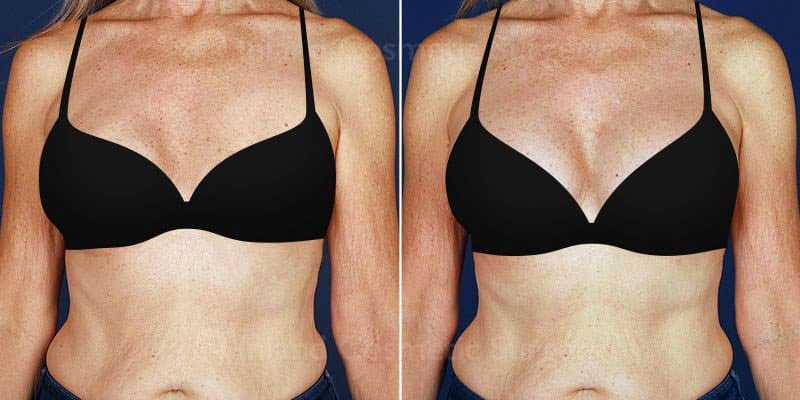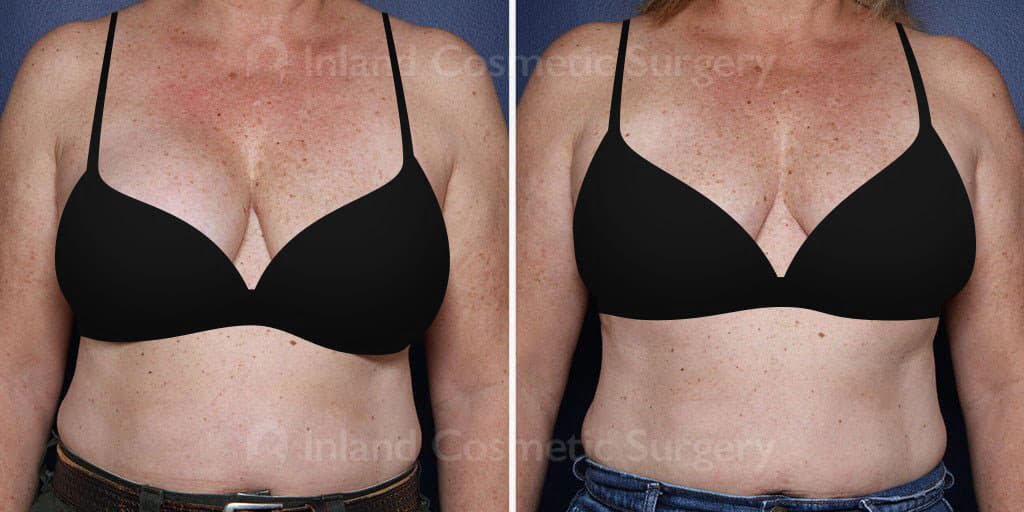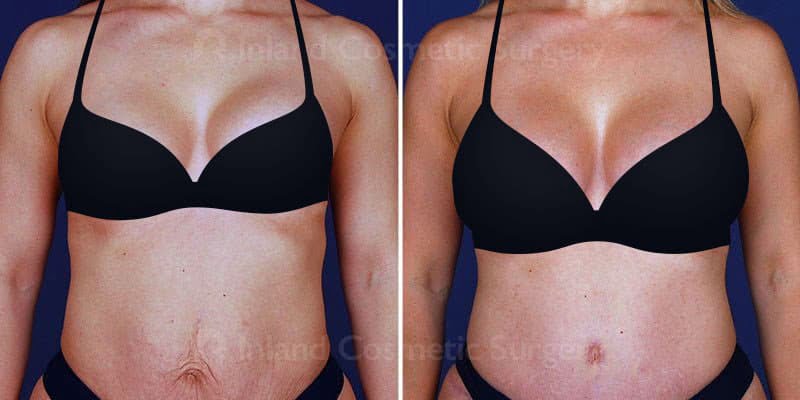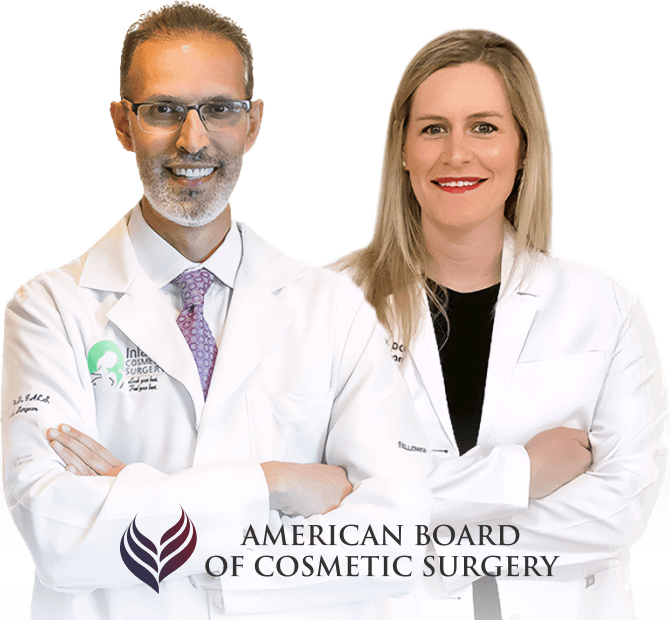If complications, the tolls of aging, or a life change have impacted your augmented breasts, our cosmetic surgeons can replace your breast implants with advanced techniques
Hundreds of thousands of women around the world get breast implants every year—and most of them love their results. But if your breasts have changed over the years, an unforeseen complication has impacted their appearance, or you were never happy with the results of your first procedure, you do have options.
Here at Inland Cosmetic Surgery, our experienced breast revision cosmetic surgeons Dr. Jacob Haiavy and Dr. Emma Ryan have helped many women who are unhappy with their first breast augmentation. Using advanced corrective techniques and suturing methods, they are able to replace your implants while ensuring your breasts have a natural, symmetrical appearance.
Revision breast surgery can improve the aesthetic results of a previous breast augmentation, breast lift, or breast reduction by switching out breast implants, lifting the breasts, or correcting an unexpected complication that has occurred.

When you should consider breast revision surgery
There are many possible reasons to seek out a revision surgery. Most patients are unsatisfied with a previous breast augmentation, either due to an aesthetic imperfection or an unwanted complication like capsular contracture. Possible reasons for breast revision may include:
- Increase or decrease implant size
- Switch from saline to silicone implants
- Visible scarring from surgery
- Implants are asymmetrical
- Breast implant rupture or deflation
- Complication (Capsular contracture, symmastia, nipple malposition)
- Implant malposition, such as implants falling too far to the side or too low
Reasons for a breast augmentation revision vary widely and range from simple to complex in nature. During your consultation, we will discuss your concerns about a previous breast surgery and determine whether breast revision can help meet your goals.
If desire to completely have your implants removed without replacing them, we also offer breast implant removal, or explant surgery.
Do breast implants really need to be replaced every 10 years?
Dr. Jacob Haiavy of Inland Cosmetic Surgery tackles one of the most frequently asked questions about breast augmentation: Do breast implants really need to be replaced every 10 years? Drawing on his extensive experience to clarify the misconceptions surrounding the lifespan of breast implants, Dr. Haiavy provides a detailed analysis of what factors can influence the longevity of implants and under what circumstances replacement might be necessary. From the types of implants to the latest surgical techniques and advancements in implant technology, Dr. Haiavy covers all aspects of breast implant durability. Whether you’re contemplating breast augmentation, approaching your 10-year implant anniversary, or simply curious about implant maintenance, this video offers valuable insights into supporting the longevity of your results.
Video Transcript
“A question that we’re asked often in the practice is, “How long will my implants last?” Very good question. You know, these are man-made devices. I’ve actually had the privilege of making implants years ago. In 2005, I visited the Mentor plant, and it was a wonderful experience to see how they make the implants—both saline and silicone. It’s a very intricate process. You go to the facility, and you see people walking around with hoods, and they have all these separations. It’s a very meticulous process, but it’s mostly man-made.
We generally say that implants last 10 years, but I’ve been in practice for over 20 years now, and I’ll tell you, more than 80% of the patients that come back at 10 years don’t need anything done. My philosophy is if you’re doing well, the implants are doing okay, and you don’t have any capsular contracture or problems, then we don’t mess with them. You don’t need to replace them every 10 years just because 10 years have passed. You just have to make sure that you continue doing breast exams on a monthly basis, get your mammograms on a yearly basis, see your OBGYN, and you can come see us for the necessary maintenance. We can do surveillance every few years.
If you have a deflation, of course, we’re going to go ahead and replace it. If your breasts, over the years, relax and sag over the implant, we can do a lift and take the opportunity to replace the implants at the same time. If you have saline implants and notice some rippling, or if you feel the implant and want something with a more natural filling, we can change them to silicone. But if there are no problems with the implants, we usually don’t have to replace them.
Our revision rate last time I measured was about 14.6% at 10 years—so less than 15%, not very high. They last quite a long time, and I’ll tell you, their quality control is excellent. These implants go through numerous quality control steps. They don’t break very easily. They will not break if someone hugs you tightly. In fact, I’ve had several patients who, unfortunately, were in car accidents, and their implants remained intact. So they can go through a lot and not break that easily. But every once in a while, they do fail. It’s not because of something you have done—it’s because either the implant valve has failed, the shell has a small crack and breaks, or there’s a hole in it just from the material degrading over time. So, yeah, they’re good products.”
What kind of complications may require a revision augmentation?
Capsular contracture
When implants are placed within the breast pocket during breast augmentation, your body forms a capsule of scar tissue around the implant as part of the healing process. While this is totally normal, on rare occasions this capsule shrinks in size and puts pressure on the breast implant. This condition is known as capsular contracture, and it can be quite uncomfortable for patients who experience it. It also can impact the appearance of the breasts, causing them to look and feel overly firm and develop a misshapen appearance.
While capsular contracture is becoming less common due to improvements in implants and placement techniques, it does occur in some women for unknown reasons. To correct it, your surgeon will need to carefully remove portions of or the entire formed capsule and implant and place new implants. The best option for you will depend on the severity of your capsular contracture, type of implant originally used, and whether or not you want your implants removed or replaced.
Symmastia or “bread loafing”
“Bread loafing” happens when breast implants end up positioned too close to the middle of the chest, giving them a fused appearance like a loaf of bread. This can result from an inexperienced surgeon placing your original implants too close to the center of the chest or using implants that were too wide for your natural body proportions.
Correcting symmastia requires removal of the original implants and careful adjustment of the breast capsule and pocket. Our cosmetic surgeons use special suturing techniques to “close off” the portion of the pocket that is extended too far, adjusting the medial fold and bringing your implants to a more natural position.
Breast implant displacement, “bottoming out” or “double bubble”
When a breast implant falls under the natural breast crease, it can make the lower half of the breast look overly full, with nipples laying unnaturally high on the breast and the upper breast appearing deflated. This can result from a surgeon placing implants too low, using an implant that is too large, or naturally lax breast tissue in the patient. Similarly, a “double bubble” can occur if the bottom portion of the implant falls beneath the inframammary fold instead of lining up with it, resulting in a dent or fold across the implant.
To address these complications, our surgeons typically have to reconstruct the inframammary fold (crease under the breast) so it can support the implant. While the breast implants won’t always need to be replaced, depending on what caused your bottoming out in the first place, you may need to consider having different implants placed to avoid a repeat of the problem.
Breast Implant Deflation
Breast implant deflation can occur at any time in the lifetime of breast implants. For patients with saline-filled breast implants, a rupture will cause the implants to physically deflate, leading to a sudden or gradual decrease in breast size. Revision surgery is needed to restore the breast’s aesthetic appearance and ensure symmetry. During the procedure, the deflated implant is removed, the implant pocket is assessed and repaired if needed, and a new implant is inserted, potentially allowing for changes in size, type, or implant placement.
What can I expect from breast augmentation revision?
The way we approach your breast revision will depend on your individual needs and reasons for the revision. Breast implant removal or exchange is a relatively simple process that requires about 1 hour of operating time. A more complex revision surgery that requires grafting can take up to three hours or more.
Our surgeons are often able to use your original breast augmentation incisions to access and replace each implant. The most significant concern with breast implant removal is the potential for an unsatisfactory aesthetic outcome. Fortunately, there are techniques (such as breast lift surgery) that can address these concerns and provide a better aesthetic result.

Your surgeon will discuss your individual surgical protocol with you during your consultation and pre-op appointment. They’ll make recommendations for your breast revision based on a number of factors, including:
- How much natural breast tissue you have
- What type of implants were used in your original breast augmentation
- The integrity of your skin
- How many breast surgeries you’ve already had
- Where your original implants were placed
- The adequacy of your tissue support
- Any additional lift needed to achieve desired results
Surgical correction of breast surgery complications is a more complex side of breast revision surgery, especially in cases of capsular contracture or infection. These situations require the expertise of an experienced breast surgeon. Revision surgery for these instances often involve techniques that repair the breast implant pocket using a tissue substitute like Alloderm or Strattice.
In all cases of revision surgery, the goal is to address your concerns and safely provide the best possible results. Although recovery time varies, many patients who undergo simple revision procedures discover that the healing process is quicker than their first breast enhancement surgery.

- Key Benefits
- Glossary
- Correction of Implant Complications: Revision can address issues such as implant rupture, capsular contracture (scar tissue squeezing the implant), or implant displacement.
- Updated Implant Size or Shape: Patients can choose to change the size or shape of their implants, either for aesthetic reasons or to suit changes in their body over time.
- Upgrading to Newer Implant Technology: Patients have the opportunity to upgrade to the latest implant technology, which may offer better safety and aesthetic results.
- Resolution of Health Concerns: If the original implants cause health issues, such as systemic symptoms attributed to implants, revision surgery can address these.
- Anesthesia: Medications used to prevent pain and alter consciousness during surgery; typically used in breast augmentation revision.
- Breast Implant Illness (BII): A term describing a variety of symptoms some believe are related to breast implants, potentially addressed in revision surgery.
- Capsular Contracture: A complication where scar tissue around the implant causes firmness, hardness, or pain, often corrected in revision surgeries.
- Implant Malposition: The displacement of a breast implant from its intended position, correctable through revision surgery.
- Implant Rupture: Breaking or leaking of a breast implant, necessitating its removal or replacement in revision surgery.
- Mammography: A breast imaging technique important for patients with implants to monitor for complications.
- Mastopexy: Also known as a breast lift, a procedure that can be combined with breast augmentation revision.
- Recovery Period: The time required after breast augmentation revision for healing and return to normal activities, varying based on the surgery’s extent and individual healing processes.
- Revision Breast Augmentation: A surgical procedure to replace, remove, or correct the results of a previous breast augmentation.
- Rippling: Visible or palpable wrinkling of implants, often addressed in breast augmentation revision.
- Scar Tissue: Fibrous tissue formed post-surgery, modifiable or removable in revision procedures.
- Subglandular Placement: Placement of implants above the chest muscle, reconsidered during revision surgery.
- Submuscular Placement: Placement of implants under the chest muscle, evaluated during a revision.
- Synmastia: A complication of implants placed too close together, addressed in revision surgeries.
- Texture: The surface characteristic of implants, either smooth or textured; a consideration in revision surgery.
Learn more about breast revision surgery during a private consultation
If you find that you are unsatisfied with results of a previous breast augmentation, breast lift, or breast reduction, our highly-trained team of Rancho Cucamonga cosmetic surgeons are experienced in breast revision and are here to help. Contact us for more information on breast surgery revision procedures in Rancho Cucamonga.
Additional procedures
We offer a complete range of surgical and non-surgical breast, body, and face procedures, and proudly serve patients from Inland Empire, Los Angeles—and even welcome patients from all over the country. We would be happy to discuss your concerns and design a treatment plan that helps you feel comfortable and confident in your body again.
Areas served:
Medically reviewed by Dr. Jacob Haiavy — Updated on Feb 24, 2025


